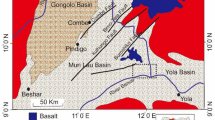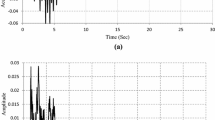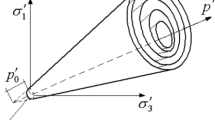Abstract
Liquefaction is the phenomena when there is a loss of strength in saturated and cohesionless soil because of increased pore water pressures and hence effective stress is reduced due to the dynamic loading. Liquefaction may cause failure of foundations, resulting in the collapse of the structure. Liquefaction depends on the characteristics of subsurface soil. Study area considered was Amaravati, de facto capital city of the Indian state of Andhra Pradesh. It is essential to evaluate the liquefaction potential and settlement analysis of the soil as the constructions are on the rise in the new capital area. Based on the borehole data collected from the study area, it is seen that the soil profile consists of the sandy layers sandwiched between two silty clay layers in many of the boreholes up to 15 m depth. In the present study, Idriss and Boulanger method (new criteria for distinguishing between silts and clays that are susceptible to liquefaction versus cyclic failure. 2005, [1]) was used and the analysis carried out by using LiqIT software. It was found from the present study that the range for the factor of safety against liquefaction is varying from 1.5 to 5.0 in few boreholes. Based on the results, the soils are not susceptible to liquefaction, and the settlements are within the permissible limits.
Access provided by Autonomous University of Puebla. Download conference paper PDF
Similar content being viewed by others
Keywords
1 Introduction
The loss of ability to bear the loads by the soil underneath is due to rapid loading like that of an earthquake is liquefaction. It is more of a fact that the soil underneath acts like liquid, mathematically explained by equating total stress and pore water pressure, thereby a zero effective stress. Liquefaction is prominent in soils of mediocre density with amounts of saturation. History shows a colossal damage is transpired due to causes of liquefaction in the mode of ground settlements, landslides, etc. [2]. Assessing the effect in prior to its occurrence can render necessary actions at times of earthquake. Many instances of liquefaction are noticed right from Niigata earthquake (1964), Alaska earthquake (1964), Loma Prieta earthquake (1989), Kobe earthquake (1995), Chi-Chi earthquake (1999), Bhuj (2001) to recent Christchurch (2010) and Canterbury (2011) earthquakes. Countries like India got stretchy coastal line, with a high probability of liquefaction taking place. Also, the country got chances of over 50% susceptible to the earthquakes [3]. The Bhuj earthquake (2001) got incidents of failures due to liquefaction, causing sand boils, rail-road and highway damage. The areas that are placed near water bodies like rivers, oceans, etc., are found to be more open to liquefaction from the observations from the past earthquakes, damaging structures like bridges, retaining walls at the sites. Generally, the effect of liquefaction is observed in loose (rarely dense) cohesionless soils, as the concept of generating negative pore pressure while in shear may help dense soils. This effect of liquefaction is predominant up to a depth of 15 m based on the literature as well as observed in the history. The present study area covering the new capital region of Andhra Pradesh is predominantly having high water table, which varies from ground surface to 5 m depth at various locations, Krishna river is flowing in the middle of the proposed area, based on the seismic Zone III as per IS 1893: 2002, and based on the Geological Survey of India, seismotectonic map (2000), which shows more than 20 faults and lineaments in this region, with major thrust from Gundlakamma fault near Ongole, and Addanki-Nujiveedu fault, which is passing through the capital region. Also at present, the population is 2 million and identified as the most futuristic state capital of India, with the expectation of 3 million population in the next 5 years with major infrastructural facilities such as Government offices, high rise structures for both commercial and residential purposes and industries in this region.
By keeping in view the importance as given above, the borehole data is collected from 24 locations from various organisations and estimated the liquefaction potential based on the well-established cyclic stress approach developed by Idriss and Boulanger [1].
2 Study Area
The study area under scope is a location having an area of 16.5 km2 in the villages of Lingayapalem, Udandarayapalem, Thalayapalem in Thullurmandal of Guntur district, and map view of area is shown in Fig. 1 representing the locations of boreholes. It is located between 80°33′3.19″ E, 16°31′15.03″ N and 80°29′2.31″ E, 16°32′37.37″ N. It is the third most populous district in Andhra Pradesh. River Krishna also partly flowing in the district and there are other small rivers and channels flowing in the district. There are hills in surrounding areas and can be found forest reserves in the north-east region. Guntur will come in Zone 3 according to IS 1893 part-I (2016) makes moderate earthquake having magnitude from 4.9 to 6 Mw. For detailed estimation of liquefaction, geotechnical data is collected from SPT test conducted at the study area up to a depth of 15 m.
3 Geotechnical Details
In the study area, SPT test was performed at different locations as shown in Fig. 1. Bedrock was observed at 15 m depth in few locations and extended to 30 m others. Site was characterised with different soils like silty clay (residual soils), silty sand, sand (alluvial soils) and stiff clay were mostly found the in eastern side and with addition to this soil, pebbles and yellowish soft disintegrated rock can be found in the western side of the area. Undisturbed and disturbed samples were collected from test site and analysed in laboratory. SPT-N values for every strata of entire soil depth were given in Fig. 2. Groundwater table influences the site effects which should be considered. Water table levels are shallow having depth up to 3–4 m at all the boreholes. It infers that their location is at the upstream side of the river.
4 Methodology
Using SPT-based empirical formulas, the quantitative assessment of liquefaction potential for study region [4] has been carried out. From IS 1893 [5], an earthquake magnitude and the site-specific surface peak ground acceleration values are taken. The adopted methodology is illustrated in Fig. 3.
-
Idriss and Boulanger approach:
-
The relationship given by Idriss and Boulanger [6] for CSR caused due to earthquake ground motion is given in Eq. (1)
where amax is the maximum horizontal acceleration at the ground surface; σvo and σ′vo are total and effective overburden stress in vertical direction, respectively; MSF = magnitude scaling factor; rd = reduction factor for depth-dependent stress; and Kσ = overburden correction factor (OCF).
Coefficient of stress reduction (rd) is represented as a function of earthquake magnitude (M) and depth (z):
where M is earthquake magnitude; z is depth (in metre).
Equations (2), (3) and (4) were reliable if depth, z ≤ 3 m. Equation (5) is used if the depth, z > 3 m.
The ratio of induced CSR during an earthquake of any magnitude to that of an equivalent CSR corresponding to a magnitude of 7.5 (M = 7.5) gives the magnitude scaling factor (MSF).
Idriss [7] modified Eq. (6) as follows:
Boulanger and Idriss [8] found that overburden stress effects on the cyclic resistance ratio (CRR). The recommended K curves are expressed as follows:
The coefficient Cσ is expressed in terms of (N1)60
where (N1)60 is the overburden stress corrected blow count.
-
Evaluation of Cyclic Resistance Ratio (CRR):
-
To get the CRR value, the following parameters are required.
-
(a)
Percentage of fines in soil mass.
-
(b)
The number of blows obtained in SPT test (N1)60 corrected to standard penetration resistance value (N1)60cs to an equivalent clean sand.
Equation (10) for calculation of CRR for cohesionless soils having fines is given by Idriss and Boulanger [6].
where
Δ(N1)60 is the correction for per cent of fines (FC) present in the soil and is mentioned in Eqs. (12) and (13),
N60 is the ‘N’ value after correction to an equivalent 60% hammer efficiency, CN is the OCF for penetration resistance and (N1)60 is the blow count corrected to overburden stress.
-
Estimation of Factor of Safety (FSLiq):
-
Quantification of liquefaction potential can be done by using the factor of safety against liquefaction (FSLiq) which can be defined by
During an earthquake, liquefaction can occur if CRR is less than cyclic stress ratio (CSR). Soil is susceptible to liquefaction if FSLiq ≤ 1.0. The higher the factor of safety, the more resistant against liquefaction. Liquefaction susceptibility has to be evaluated at the required depth in the soil mass, as the CSR and CRR will vary with the depth of the soil bed.
5 Results and Discussions
The seismic moment magnitude scale (Mw) and peak ground surface acceleration (PGA) values are the essential seismic input parameter in the liquefaction hazard analysis. In this study, Chamoli earthquake of magnitude 5.4 is taken. PGA at surface was taken at different boreholes by ground response analysis using DEEPSOIL software. Liquefaction analysis was carried out in LiqIT software which gives deterministic values considering SPT-N values at different locations. From the collected bore log data, the water table is observed very high (<3 m from ground surface) in nearby areas of Krishna river. In such situations, it becomes essential to identify the liquefiable soil layers within upper 15 m strata, especially with sandy soils, which can be susceptible to liquefy in future. The following are results obtained at different boreholes in the study area.



From results, it is observed that factor of safety obtained is greater than 1 and it goes to 5 at greater depths indicating that soil is not probable to liquefy and the settlements obtained are 12.4 mm at A-5, 8.8 mm at B-3 and 3.4 mm at C-5 boreholes, respectively, which is in permissible limits (25 mm). Due to high SPT-N value (>10) the sandy soil is not probable to liquefy which is observed in the soil profile of each borehole. Though, the water table is below the 2 m from surface in all the boreholes the soil is having high density to resist the earthquake vibrations against liquefaction.
6 Conclusions
-
1.
Analysis of liquefaction is attempted using SPT-based method Idriss and Boulanger [4]. Liquefaction analysis at various boreholes has been prepared which show the maximum depth of liquefaction is around 15 m by using LiqIT software.
-
2.
It is observed that the boreholes such as A-5, B-3, C-5 in three different grids of our study area are not liquefied due to high SPT-N values. Looking at the scenario of soil profile of the study area, the sites can resist the vibrations of earthquake against liquefaction.
-
3.
Settlements at A-5, B-3, C-5 boreholes are within permissible limits (25 mm). The soils can withstand against huge deformations which indicates that structures are safe against earthquake induce settlement.
References
Boulanger, R. W., & Idriss, I. M. (2005). New criteria for distinguishing between silts and clays that are susceptible to liquefaction versus cyclic failure. In Proceedings Technologies to Enhance Dam Safety and the Environment, 25th Annual United States Society on Dams Conference (pp. 357–366).
Borcherdt, R. D. (1991). On the observation, characterisation, and predictive GIS mapping of strong ground shaking for seismic zonation: A case study in the San Francisco Bay region, California. Bulletin of the New Zealand National Society for Earthquake Engineering, 24(4), 287–305.
Kolathayar, S., Sitharam, T. G., & Vipin, K. S. (2014). Probabilistic liquefaction potential evaluation for India and adjoining areas. Indian Geotechnical Journal, 44(3), 269–277.
Idriss, I. M., & Boulanger, R. W. (2010). SPT-based liquefaction triggering procedures. Rep. UCD/CGM-10, 2, 4–13.
Bureau of Indian Standards. (2002). Criteria for earthquake resistant design of structures. IS 1893(Part 1).
Idriss, I. M., & Boulanger, R. W. (2006). Semi-empirical procedures for evaluating liquefaction potential during earthquakes. Soil Dynamics and Earthquake Engineering, 26(2–4),115–130.
Idriss, I. M. (1999). An update to the Seed-Idriss simplified procedure for evaluating liquefaction potential. Proc., TRB Worshop on New Approaches to Liquefaction, Pubbl. n. FHWA-RD-99-165, Federal Highway Administation.
Boulanger, R. W., & Idriss, I. M. (2004). State normalization of penetration resistance and the effect of overburden stress on liquefaction resistance. In Proceedings 11th SDEE and 3rd ICEGE. Berkeley, CA: University of California.
Seed, H. B., & Idriss, I. M. (1971). Simplified procedure for evaluating soil liquefaction potential. Journal of Soil Mechanics & Foundations Div.
Kramer, S. L. (2003). Geotechnical Earthquake Engineering. New Delhi: Pearson Education (Singapore) Private Ltd.
Satyam, N. D., & Towhata, I. (2016). Site-specific ground response analysis and liquefaction assessment of Vijayawada city (India). Natural Hazards, 81(2), 705–724.
Putti, S. P., & Satyam, N. (2018). Ground response analysis and liquefaction hazard assessment for Vishakhapatnam city. Innovative Infrastructure Solutions, 3(1), 12.
Rao, G. V., Subba, R., & Sai, B. U. (2018). Seismic liquefaction analysis of capital region of Andhra Pradesh State, India. Civil Engineering Journal-stavebni Obzor, 2.
Author information
Authors and Affiliations
Corresponding author
Editor information
Editors and Affiliations
Rights and permissions
Copyright information
© 2020 Springer Nature Singapore Pte Ltd.
About this paper
Cite this paper
Kiran, D.N., Khan, M.M., Reddy, M.M., Reddy, K.R.S., Kumar, G.K. (2020). Numerical Analysis of Liquefaction and Settlement in Layered Soils. In: Saride, S., Umashankar, B., Avirneni, D. (eds) Advances in Geotechnical and Transportation Engineering . Lecture Notes in Civil Engineering, vol 71. Springer, Singapore. https://doi.org/10.1007/978-981-15-3662-5_7
Download citation
DOI: https://doi.org/10.1007/978-981-15-3662-5_7
Published:
Publisher Name: Springer, Singapore
Print ISBN: 978-981-15-3661-8
Online ISBN: 978-981-15-3662-5
eBook Packages: EngineeringEngineering (R0)







